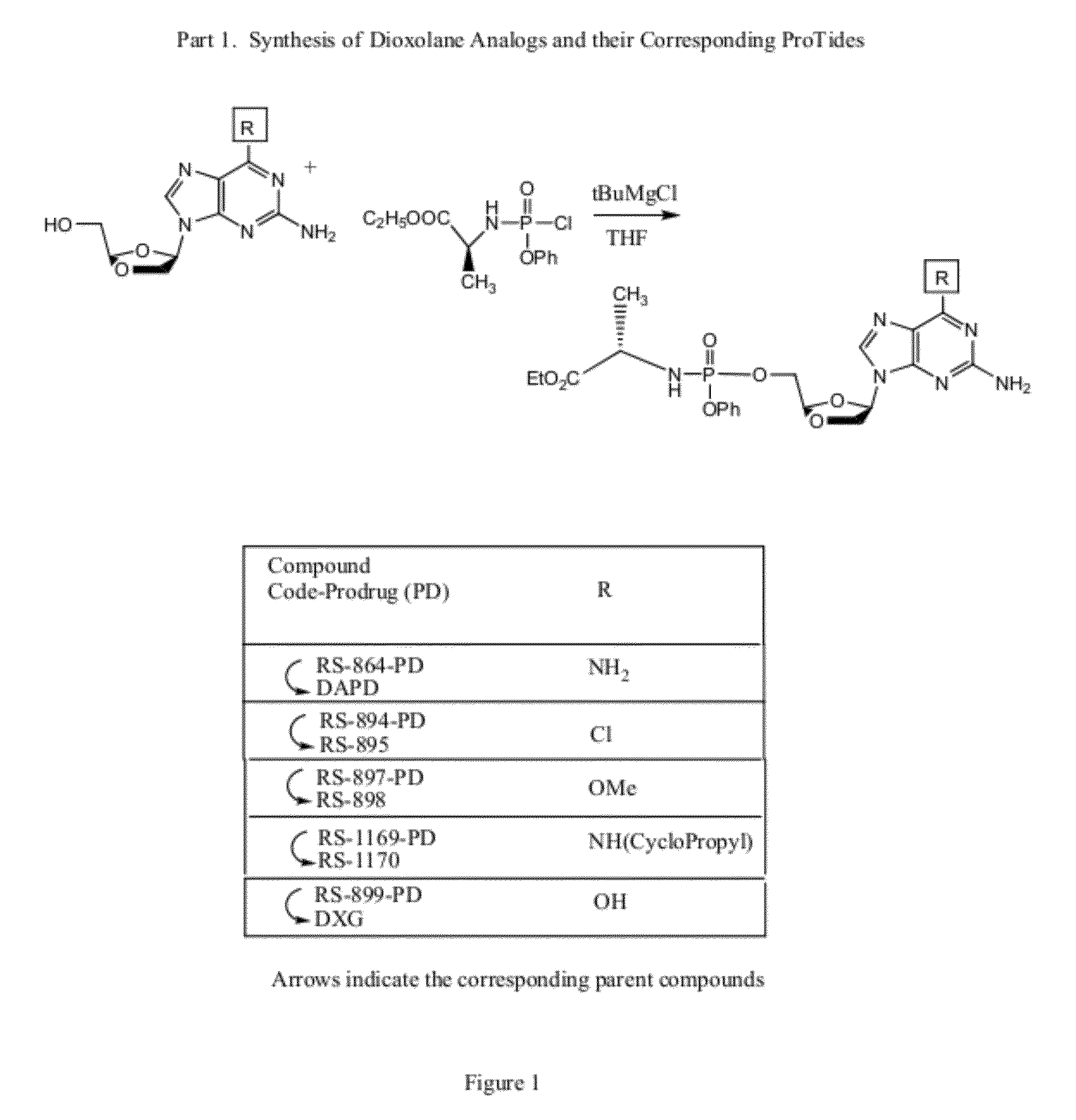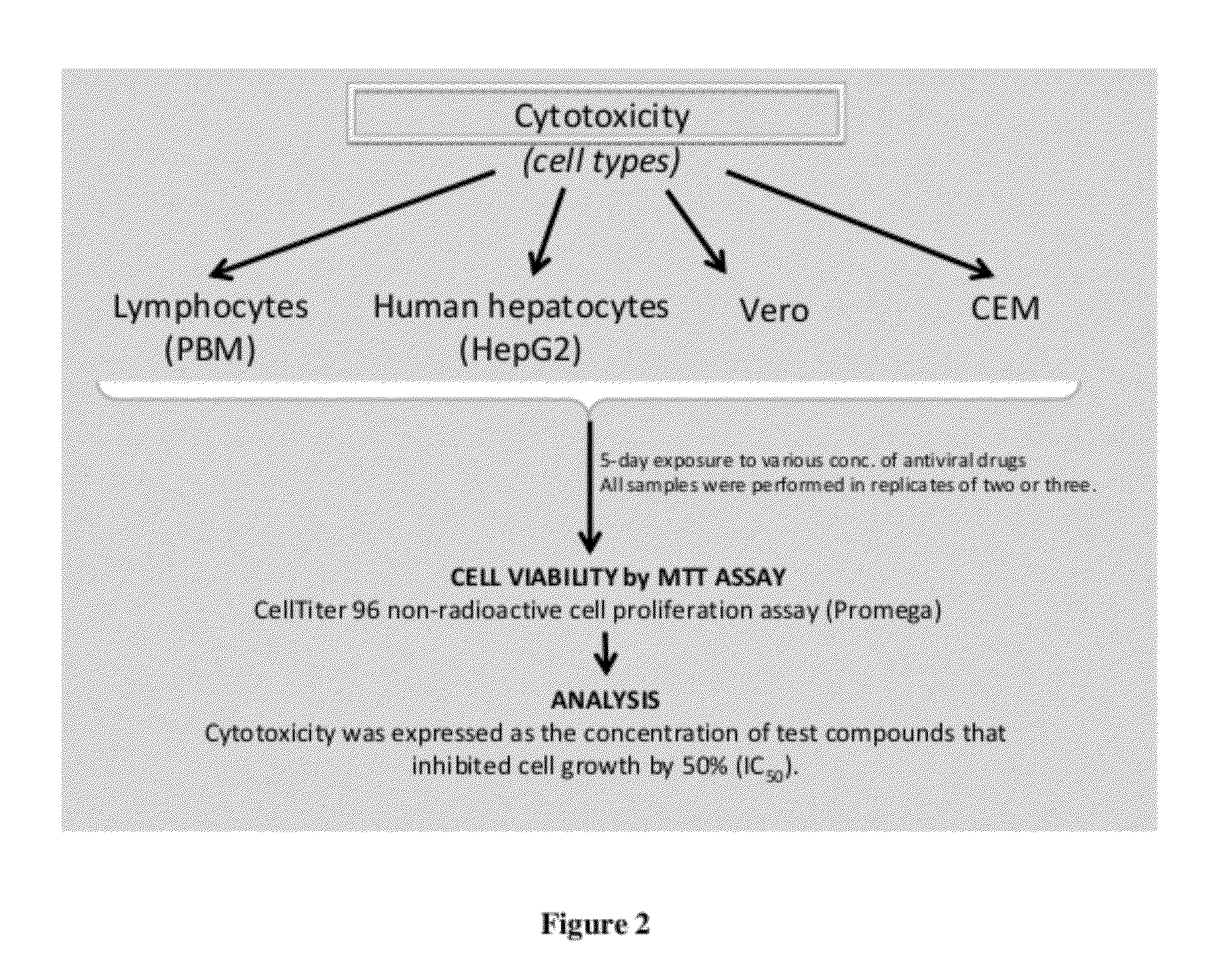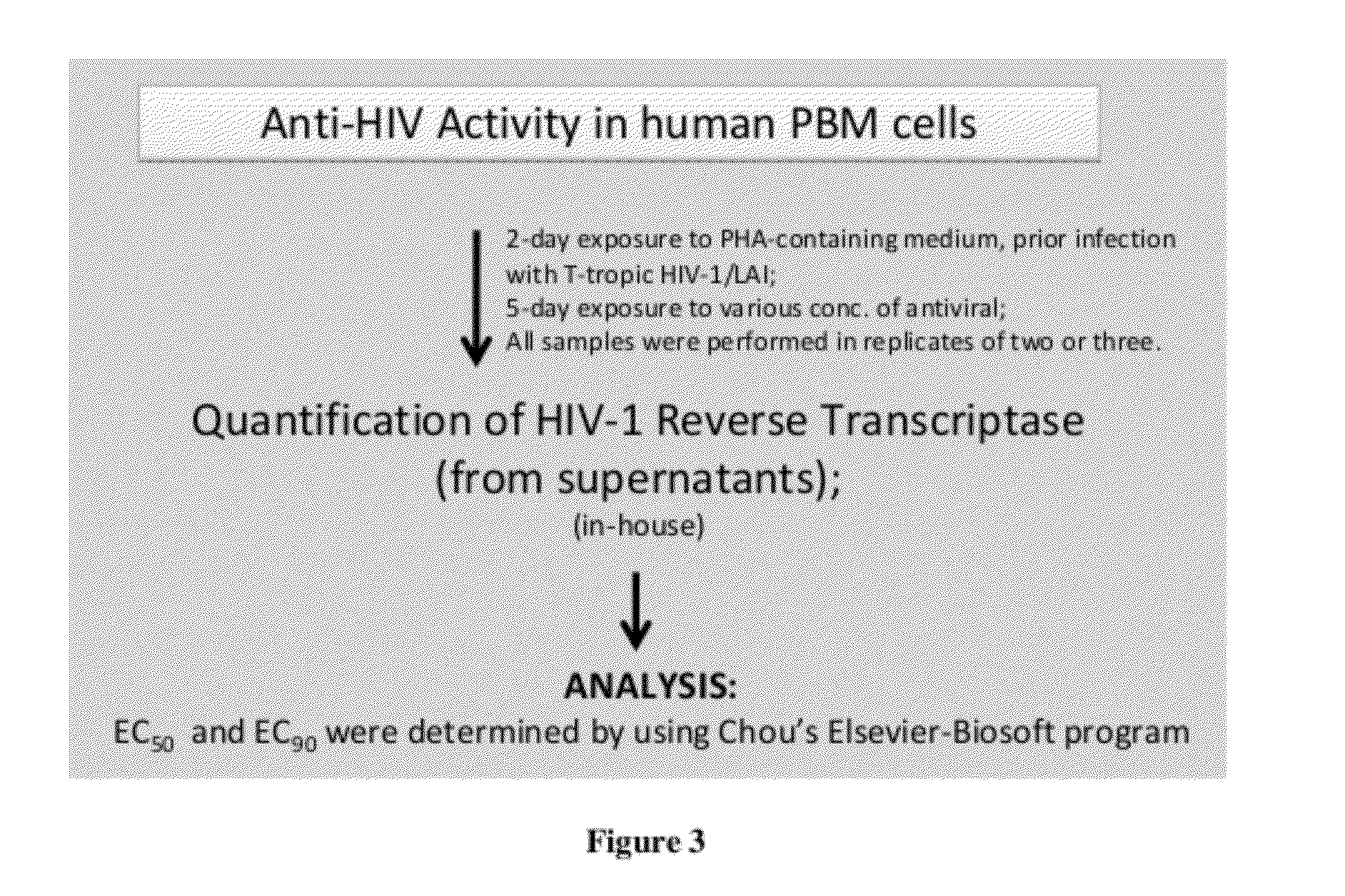Monophosphate prodrugs of dapd and analogs thereof
a technology of monophosphate and prodrugs, which is applied in the field of 6substituted2amino purine dioxolane monophosphate and monophosphate prodrugs and modified prodrug analogs, can solve the problems of limiting future treatment options, reducing the effect of drug safety, and increasing the risk of severe side effects, so as to improve the absolute antiviral effect of the drug, reduce the toxicity, and increase the effect of the drug
- Summary
- Abstract
- Description
- Claims
- Application Information
AI Technical Summary
Benefits of technology
Problems solved by technology
Method used
Image
Examples
example 1
Preparation of DAPD
[0319]
Step 1: Silylation of 2,6-diaminopurine
[0320]
[0321]750 mg of 2,6-diaminopurine, 750 mg of ammonium sulfate and 20 mL of hexamethyldisilazane were added into a 250 mL three-neck flask. The suspension was heated to reflux with stirring at 130-135° C. (oil-bath) for 4 h. During this period the solution becomes homogeneous. The solution was cooled to 85° C. and the excess hexamethyldisilazane was subsequently distilled off under gradually decreasing reduced pressure. After the hexamethyldisilazane was removed completely, the residue was cooled to rt under vacuum then 10 mL of anhydrous methylene chloride was added to prepare a solution.
Step 2: Preparation of (2R-4R / S)-4-acetoxy-2-isobutyryloxymethyl-1,3-dioxolane
[0322]
[0323]To a well stirred solution of LiAl(OtBu)3H (25.4 g, 100 mmol) in dry THF (150 mL) at −10 to −20° C. was added a pre-cooled isobutyric acid-4-oxo-[1,3]-dioxolan-2-(R)-yl methyl ester (12.5 g, 66 mmol) over a period of 10 min under N2 atmospher...
example 2
(2R)-ethyl-2-((((4R)-4-(2,6-diamino-9H-purin-9-yl)-1,3-dioxolan-2-yl)methoxy)(phenoxy)phosphorylamino)propanoate (77)
[0332]As shown above, to a solution of DAPD (30 mg, 0.12 mmol) in THF (5 mL) was added 1 M solution of t-BuMgCl (0.36 mL, 0.36 mmol) and stirred for 30 min. To the reaction mixture was added (2R)-ethyl 2-(chloro(phenoxy)phosphorylamino)propanoate (0.36 mL, 0.36 mmol) in THF at rt and was stirred overnight, neutralized with ammonium chloride(aq), conc, the crude mixture was purified by flash column chromatography with ethyl acetate:methanol=5:1 to give 77 (28 mg, 46%).
[0333]1H-NMR (CD3OD, 300 MHz) δ: 7.80-7.79 (s, 1H), 7.26-7.09 (m, 5H), 6.27 (m, 1H), 6.12 (brs, 2H), 5.25 (m, 3H), 4.47 (m, 2H), 4.22 (m, 2H), 4.03 (m, 2H), 3.83 (m, 1H), 1.33-1.15 (m, 6H).
[0334]LC / MS calcd. for C20H27N7O7P 508.2, observed: 508.3 (M+1).
[0335]The same chemistry can be used to prepare 6′-substituted analogs of DAPD, for example, those in which the 6′-position includes a halo (i.e., Cl, Br, ...
example 3
Conversion of 6-substituted-2-amino purine dioxolanes to 6-hydroxy-2-amino purine dioxolanes
[0336]The various nucleosides prepared as described above, with functionality at the 6′-position other than a hydroxy group, are readily converted, in vivo, to the 6′-hydroxy form when the 5′-OH group is not converted to the monophosphate prodrug.
[0337]The metabolism of (−)-β-D-2,6-diaminopurine dioxolane (DAPD) in PHA-stimulated human PBMCs and CEM cells was previously assessed (Antimicrob. Agents Chemother. 2001, 45, 158-165). In this previous study DAPD was found to readily deaminate to (−)-β-D-dioxolane guanine (DXG). While both DXG and DAPD were detected, DAPD levels in PBMCs were 27-fold higher than the level of DAPD determined in CEM cells; the level of DXG was roughly the same in both cell types. The intracellular levels of DAPD and DXG and their phosphorylated derivatives were quantitated in the same previous study. No phosphorylation of DAPD to the corresponding mono-, di-, or triph...
PUM
| Property | Measurement | Unit |
|---|---|---|
| enantiomeric excess | aaaaa | aaaaa |
| enantiomeric excess | aaaaa | aaaaa |
| temperature | aaaaa | aaaaa |
Abstract
Description
Claims
Application Information
 Login to View More
Login to View More - R&D
- Intellectual Property
- Life Sciences
- Materials
- Tech Scout
- Unparalleled Data Quality
- Higher Quality Content
- 60% Fewer Hallucinations
Browse by: Latest US Patents, China's latest patents, Technical Efficacy Thesaurus, Application Domain, Technology Topic, Popular Technical Reports.
© 2025 PatSnap. All rights reserved.Legal|Privacy policy|Modern Slavery Act Transparency Statement|Sitemap|About US| Contact US: help@patsnap.com



